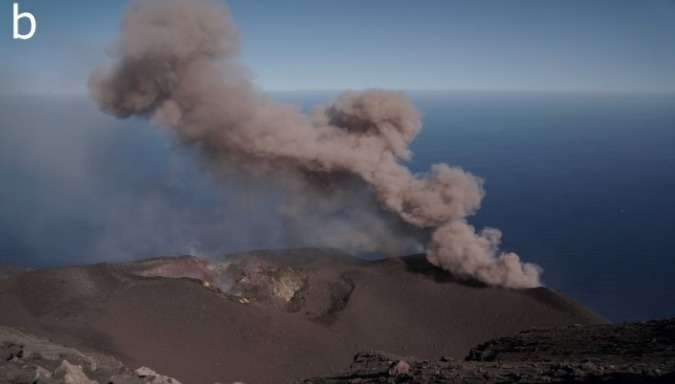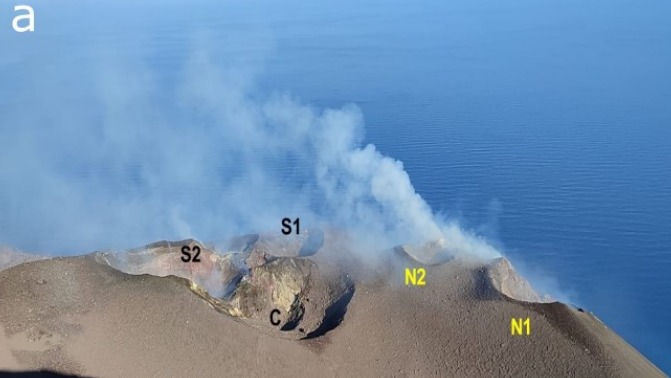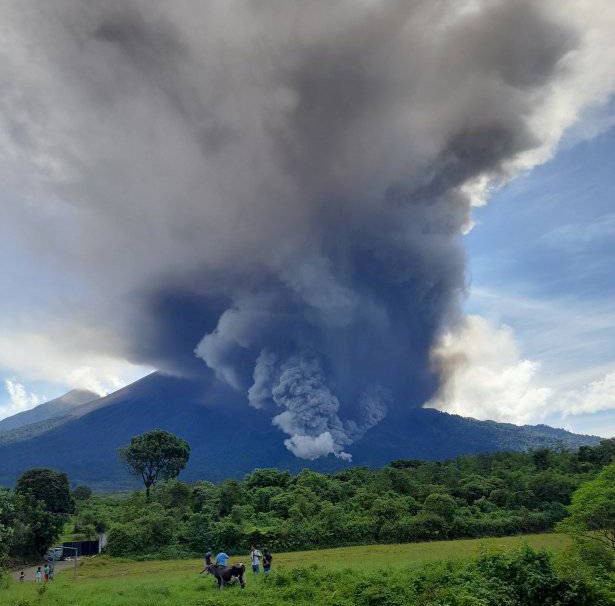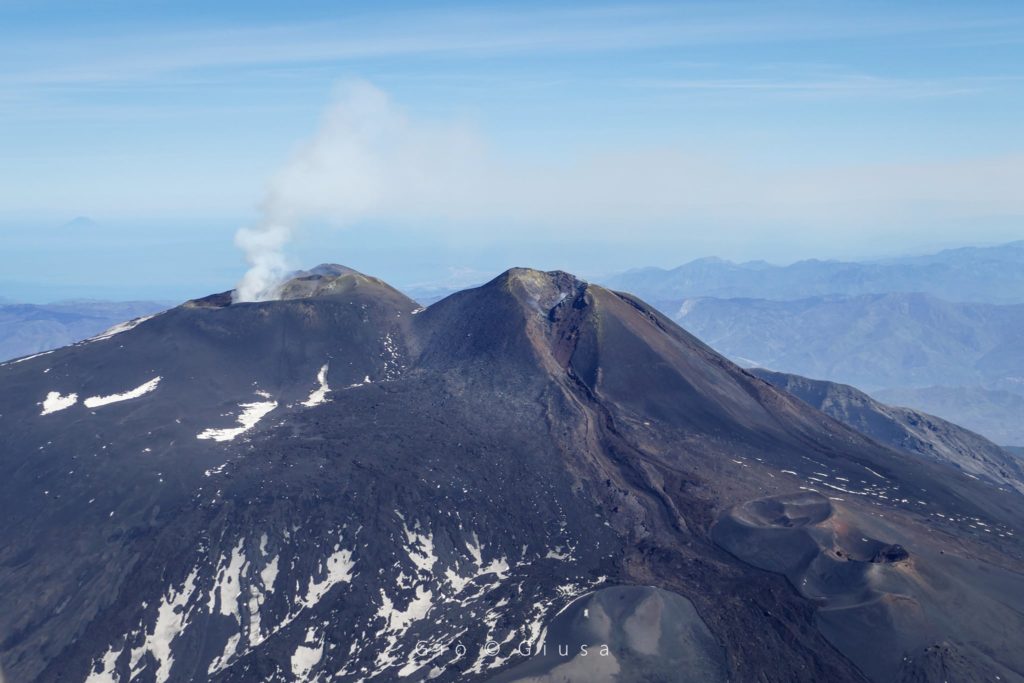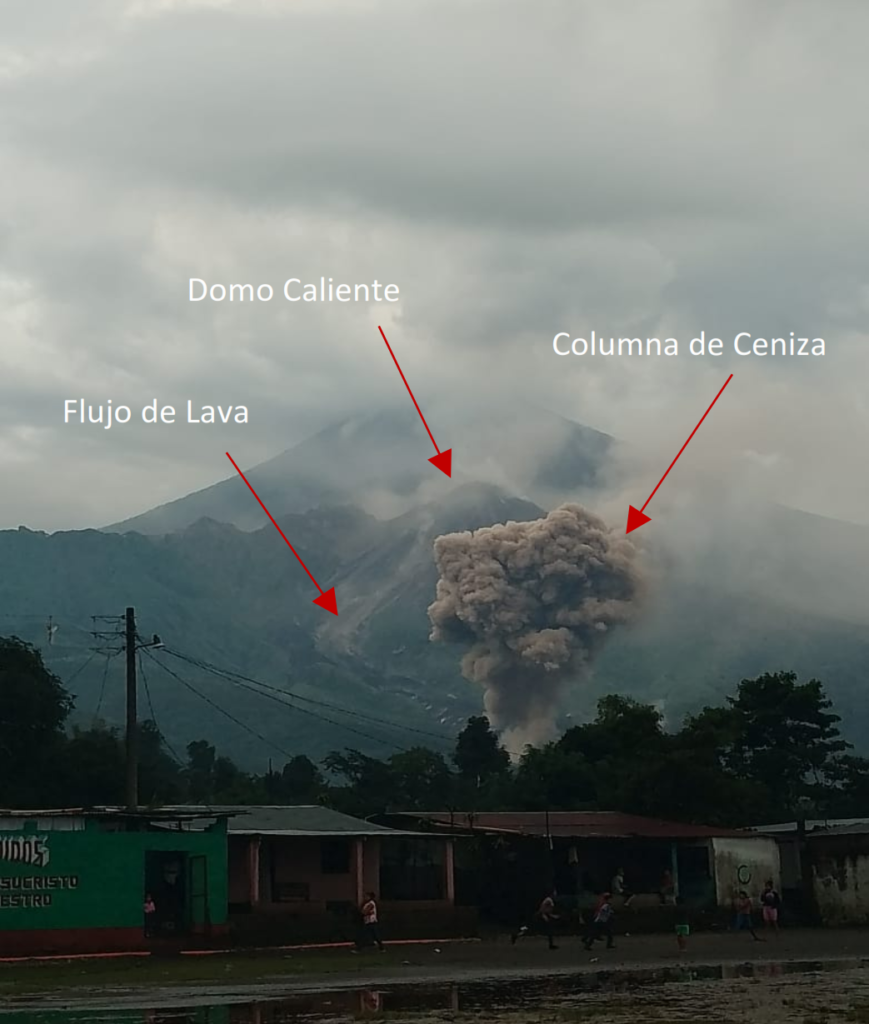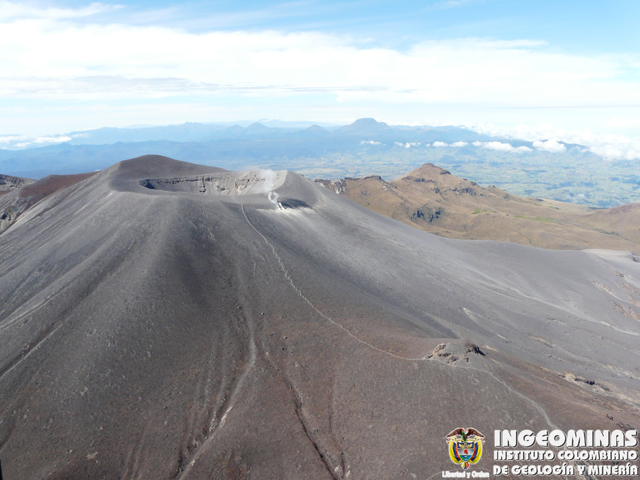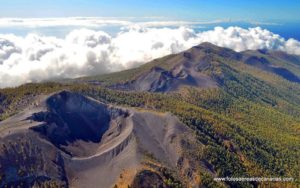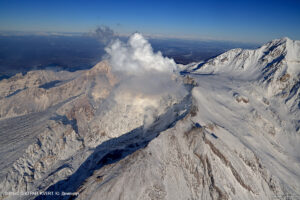July 06 , 2022.
Italy , Stromboli :
WEEKLY BULLETIN, from June 27, 2022 to July 03, 2022. (issue date July 05, 2022)
ACTIVITY STATUS SUMMARY
In the light of the surveillance data, it is highlighted:
1) VOLCANOLOGICAL OBSERVATIONS: During this period, normal explosive activity of the Strombolian type was observed. The total hourly frequency of explosions was almost constant on low values (3-4 events/h). The intensity of the explosions was low to medium, both in the area of the North crater and in the area of the Center-South crater.
2) SISMOLOGY: The seismological parameters monitored do not show any significant changes, with the exception of the low frequency abnormal event recorded on 06/29.
3) GROUND DEFORMATIONS: During the period under review, the island’s ground deformation monitoring networks did not record any significant variations.
4) GEOCHEMISTRY: SO2 flux at a low level
C/S ratio in the plume on high average values (C/S = 12.57).
Flux of CO2 on the floor of the crater (Pizzo) on average values (about 7000 g/m2*g).
The isotopic ratio of Helium dissolved in the thermal aquifer is at high average values (R/Ra 4.35).
5) SATELLITE OBSERVATIONS: The thermal activity observed by satellite in the summit area was at a low level.
a) Overview of the crater terrace with the names of the sectors and their locations;
Observations of explosive activity captured by surveillance cameras:
The N1 crater, with two emission points, located in the North crater area produced explosions of low intensity (less than 80 m high) to medium (less than 150 m high) emitting fine materials (ash) sometimes mixed with coarse materials (bombs and lapilli). The N2 crater showed continuous, sometimes impulsive, diffuse degassing. The average frequency of explosions was almost constant with 2-3 events / h.
In the Center-South zone, craters C and S1 did not show significant explosive activity. In detail, the S2 crater, with two emission points, showed explosions of mostly low intensity (less than 80 m high) and sometimes medium (less than 150 m) emitting fine matter. The frequency of explosions varied between absent and less than 1 event/h.
b) Explosion through the mouth (Pizzo side) present in sector N1.
Observations on the ground following the inspection in the summit area.
As part of the UN departmental project, on the mornings of June 29 and 30, researchers observed eruptive activity between the Pizzo and the Elipista shelters and those of the Roccette. Activity in general is low both in intensity of explosions and in number of events.
In the Center-South zone (Photo A) there was a weak and discontinuous degassing in the southern part (S2), the S1 crater showed no degassing, while at the central crater (C) the degassing was very mild and located along the walls of a small circular closed mouth present on the bottom of the crater.
In the North zone, the N2 crater showed a modest and discontinuous degassing on June 29 which was then absent on the morning of June 30. However, there was also intense outgassing activity from a vent positioned on the outer side of N2 (Sciara side) (Photo A). The most active crater was N1, where there were at least 2 main vents, the first facing the Pizzo and producing ash emissions on both days, sometimes abundant and prolonged in time (especially June 30; Photo B) ; the second vent, facing the Sciara, emitted ash mixed with coarse incandescent products on June 29, while the day after its activity showed a decrease in coarse material content, resulting more similar to the first vent with an emission abundant ash. This activity was almost silent and not associated with explosions.
Source and photos : INGV.
Guatemala , Fuego :
VOLCANOLOGICAL SPECIAL BULLETIN, UPDATE ON VOLCANIC ACTIVITY.
Following the BEFGO special bulletin n°056-2022 issued on July 4, the effusive activity of the Fuego volcano has decreased, however it still maintains a lava flow 200 meters in length towards the Ceniza ravine. . During the last hours, the activity in the crater generated weak, moderate and some strong explosions accompanied by a weak shock wave and abundant ash columns with heights of 4,800 meters above the level of the sea (15,748 feet) which are scattered to the west and southwest of the volcanic complex, at a distance of about 30 kilometers. Ash falls are reported in the communities of Santa Sofía, Morelia, Panimaché I and II, El Porvenir and others in these directions.
Seismic and acoustic monitoring parameters, as well as observations made in the field by observers from the Fuego Volcano Observatory (OVFGO) indicate that the lava flow will disappear in the next few hours or days. However, it should be taken into account that there is always the probability of sudden increases in activity in the coming days or weeks, which could generate more lava flows in other ravines, prolonged periods degassing and moderate to strong avalanches in one of the canyons.
It is necessary to consider the rains that generate high values of precipitation around the Fuego volcano, because they remobilize the material previously deposited in the ravines. Mainly, the eruptive activity of March accumulated abundant materials in the Ceniza ravine, so that moderate to strong lahars will continue to be generated, causing siltation and overflow of materials in the lower parts at the height of the passage of vehicles between Osuna and Siquinalá. Therefore, all necessary precautions must be taken, mainly in the afternoon and at night, when the lahars descend.
Source : Insivumeh.
Photo : Gustavo Chigna.
Italy / Sicily , Etna :
WEEKLY BULLETIN, from June 27, 2022 to July 03, 2022. (issue date July 05, 2022)
ACTIVITY STATUS SUMMARY
In the light of the surveillance data, it is highlighted:
1) VOLCANOLOGICAL OBSERVATIONS: Degassing activity of the summit craters.
2) SEISMOLOGY: Low seismic activity of fracturing, tremor amplitude at medium-high levels.
3) INFRASOUND: Fluctuating infrasound activity, sources concentrated near Bocca Buova
4) GROUND DEFORMATIONS: GNSS data show a resumption of inflation.
5) GEOCHEMISTRY: SO2 flux at an average level
The flux of CO2 from the ground is at low average values.
The partial pressure of dissolved CO2 in the aquifer shows values in seasonal variability.
The latest Helium data refer to the date of 06/23/2022 and are at medium-high values.
6) SATELLITE OBSERVATIONS: Thermal activity in the summit area was at a high level consistent with effusive activity which ended on June 16th. In the days that followed, especially this last week, the level was low.
VOLCANOLOGICAL OBSERVATIONS
During the week under review, the monitoring of Etna’s volcanic activity was carried out thanks to the analysis of images from the network of INGV surveillance cameras, Etneo Observatory (INGV-OE).
Overall, the state of activity of the summit craters showed no change from what had been observed the previous week. In particular, the degassing activity of the summit craters was mainly carried out by the craters of collapses located in the North-West sector of Bocca Nuova, characterized by an intense sometimes impulsive degassing.
The Southeast Crater, on the other hand, showed widespread degassing related to fumarole systems present along the edges of the crater.
Finally, the Voragine crater shows no degassing activity, while weak gas emissions affect small fumaroles in the inner walls of the Northeast crater, whose crater floor is blocked.
Source : INGV.
Photo : Gio Giusa
Guatemala , Santiaguito :
VOLCANOLOGICAL SPECIAL BULLETIN: UPDATE ON VOLCANIC ACTIVITY.
In the follow-up to the BESAN 003-2022 bulletin, it is reported that the Santa María-Santiaguito volcanic complex continues in a period of high extrusive activity which, in recent months, has built a blocky lava flow, which begins in the upper part of the southwest flank of the Caliente dome and moves along the San Isidro channel. Today, this lava flow has an approximate length of 3385 meters. The topology or shape of this lava flow is dominated by unstable stacked blocks, both in its upper part and on its lateral edges and frontal part, which, when they collapse, can frequently cause avalanches and flows pyroclastics with weak to moderate characteristics, favoring incandescence and the emission of fine ash easily moved by the wind.
Simultaneously, during the previous months, constant degassing, weak explosions and avalanches of moderate to strong characteristics were generated from the Caliente dome.
This level of activity is expected to continue in the coming weeks and the possibility of further material collapses and the lava flow increasing its lateral and vertical dimensions is not excluded. Also with weak to moderate explosions which produce degassing and columns of ash at 3,500 meters above sea level (11,482 feet).
Source and photo : Insivumeh.
Colombia , Puracé :
Weekly bulletin on the activity of the Puracé volcano – Los Coconucos volcanic chain
The activity level of the volcano continues at the Yellow Activity Level or (III): changes in the behavior of volcanic activity.
From the analysis and evaluation of the information obtained through the monitoring network of the Puracé volcano – Los Coconucos volcanic chain, during the week between June 28 and July 4, 2022, the COLOMBIAN GEOLOGICAL SERVICE – Volcanological Observatory and Seismological of Popayán informs that:
During this week, the strong occurrence of earthquakes associated with the movement of fluids inside the volcano continues. A total of 663 seismic events were presented, of which 117 were associated with rock fracturing processes (type VT) and 562 with fluid dynamics in volcanic conduits; of these, 464 were classified as long period type events (LP type), 39 were associated with both failure mechanisms and fluid dynamics and were classified as hybrid type (HB type), 29 were were classified as low frequency events (type BF), six (6) as « tornillos » type earthquakes (type TO) and 46 as low energy tremor pulses (type TR).
The geodetic network of GNSS (Global Navigation Satellite System) stations for monitoring ground deformation continues to record a process associated with inflation.
With regard to the monitoring of volcanic gases, the sulfur dioxide (SO2) flux emissions recorded by the telemetric stations showed a stable behavior, reaching flow values in the permanent stations with a maximum emitted of 1709 t/ d for June 28th. For the monitoring of surface activity, the images obtained during the week thanks to the Anambío, Mina, Lavas Rojas and Cerro Sombrero web cameras showed degassing of the volcanic system, with a white column oriented preferentially towards the North-West. .
Therefore, it is concluded that significant variations in volcanic activity continue to be recorded, in accordance with the behavior expected at activity level III (yellow level), which could evolve towards states of greater activity. The Colombian Geological Service continues to monitor the evolution of the volcanic phenomenon and will report any changes that may occur in due course.
Source : SGC.
Photo : Ingeominas.

